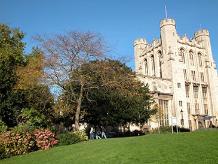 The National Lottery Heritage Fund is in place to connect people and communities with local and national heritage, and in partnership with this fund we are embarking on an exciting project! The South West Anarchy Research Project will build a bridge between the community and a variety of archaeological sub-projects, relating to the concept of ‘1000 years of Anarchy’.
The National Lottery Heritage Fund is in place to connect people and communities with local and national heritage, and in partnership with this fund we are embarking on an exciting project! The South West Anarchy Research Project will build a bridge between the community and a variety of archaeological sub-projects, relating to the concept of ‘1000 years of Anarchy’.
So firstly, what IS anarchy in archaeology?
Most of us will have heard the word anarchy at some point, and the word itself is often associated with unrest, chaos and a lack of government. But broadly, in anthropology and archaeology, the study of anarchy is interested in the ways that resistance within hierarchical societies exists. But how can we see these kinds of resistances? And what do they mean for archaeological study? In early medieval archaeology things like evidence of fortification can tell us about conflicts and alliances, and in modern archaeology, small resistances from communities can be seen in things such Bristol’s own rich tapestry of graffiti. What is clear is that anarchy is not an exclusively historical or an exclusively modern concept – it has been present wherever there is ordered hierarchy in a society. So let’s investigate!
ANARCHY IN MEDIEVAL ENGLAND
The first anarchy period in England happens over 19 years, from around 1135AD to 1153AD. The catalyst of these years of civil unrest and chaos was a classic fight for the throne. In 1135, William the Conqueror’s son, King Henry I died, and a succession battle took place between his daughter, Empress Matilda and her cousin, Stephen of Blois. Both grandchildren of William the Conqueror, the country was plunged into civil war. What we as archaeologists see as the product of this battle for the crown are things like castles cropping up across the country, churches and other usually unprotected buildings being fortified and coins with both Matilda and Stephen on appearing as people tried to make their allegiances clear and known.
The South West of England played a key role in this period of anarchy, and SWARP has two very exciting sites that we are and will be working on over the next few years. Where study of the anarchy period has usually focused on castles and classic means of fortification, we are now also looking further afield at the bigger picture.
Hartygrove, South Gloucestershire
Every year, the Department of Anthropology and Archaeology run a student training excavation – three weeks of digging, discovery and experience for our wonderful students. After 15 years of digging at Berkely Castle, we are now excavating a site in South Gloucestershire! So far, the students, staff and the Thornbury Archaeology Group have uncovered what is currently thought to be a medieval hunting lodge with an associated kitchen building and extensions to the original lodge.

So what are medieval hunting lodges?
Nobility in England and indeed further afield have long had a thirst for hunting, but as this often required travelling to a prime hunting ground or destination, hunting lodges were built for the nobles to reside in during their trips. These are often uncovered with kitchen buildings, separate to the main lodge so that the nobles could be served and fed throughout their stay. This bears great similarity to what we have begun to uncover at Hartygrove.
Bristol Castle
While most of us who live, work and study in Bristol will have walked through Castle Park at some point or other, how many of us know that beneath our feet are the remains of a great castle, demolished in 1656 by order of Oliver Cromwell? Originally built for Bishop Geoffrey of Coutances, the half-brother of William the Conqueror, Bristol Castle quickly become one of the most important castles of Norman origin in England. Built in a very strategic location, Bristol Castle was surrounded by water, sitting on the river, meaning that it was incredibly well defended from attack and siege. Multiple phases of fortification were added to the castle throughout it’s existence, furthering this defensible status. When we look at this castle through the lens of anarchism, and relating to the anarchy period that SWARP is investigating (1135-1153AD), this really is a key site. Alongside Empress Matilda’s rebels rallying at the castle, and it becoming an impregnable stronghold, Stephen of Blois was captured and imprisoned inside the castle walls in ¬1141.

These two sites are of great interest to the South West Anarchy Research Project, and we will be bringing them to life so that we can all gain a better understanding of the history and heritage of our local areas.
ANARCHY IN 17TH CENTURY ENGLAND
The next key period of anarchy that SWARP encounters is the English Civil War (1642-1651). A period of civil unrest, rebellion and all out war, these 19 years were triggered by the unpopularity of Charles I’s regime. Three wars ensued between the supporters of Charles I, and those who were loyal to Parliament, where up to 200,000 people lost their lives.
Royal Fort Gardens and House
 During these years of Civil War, what we see today as the historic environment changed drastically. Buildings all across the country were heavily fortified, be them castles or not, and many of the ruined castles that we see across the English landscape today were destroyed as a result of this catastrophic conflict.
During these years of Civil War, what we see today as the historic environment changed drastically. Buildings all across the country were heavily fortified, be them castles or not, and many of the ruined castles that we see across the English landscape today were destroyed as a result of this catastrophic conflict.
As we edge closer to the spring and summer months, Bristol students and locals will start to fill the lush green lawns of Royal Fort Gardens, bathing in the sun or sitting in the shade of the magnificent house. But if we throw our minds back to the 17th century, what would we see?
While the house that stands today was built in the 18th century, it was preceded by five bastions designed by Dutch military engineer, Sir Bernard de Gomme. These bastions were one of the very few sites that were constructed solely for defensive purposes during this time. They acted as the western headquarters of the Royalist army and were said to have been the strongest defenses in Bristol. Evidence of this defensive site were excavated by the University of Bristol in 2001, 2009 and in 2021.
SWARP will continue to research and process everything that was found during these excavations, and begin to bring together these tales of anarchy throughout history in the South West!
ANARCHY IN THE MODERN AGE

The underground scene in Bristol and the South West in the last 40-50 years is one that is entwined with the art and music scene. Much of the original underground music scene in Bristol holds its roots in Caribbean influence; recent years have rightly reminded us of the origins of the city of Bristol, and the movement of black Caribbean peoples. This combined with the punk movement in Bristol gave way to an original music scene, in turn giving way to hip-hop culture in the 1980’s. With this, came a rise in graffiti art around the city, with renowned artists like Robert Del Naja (AKA 3D) and Banksy working in and on the city. The underground scene, by definition is removed from the mainstream, and music and art produced is often associated with political statement and rebellion. An important element of the SWARP project is going to investigate the heritage of Stokes Croft and it’s graffiti in particular – there is often a narrative of illegality surrounding graffiti, and the word ‘vandalism’ is thrown around frequently. SWARP is going to research and survey the buildings throughout Stokes Croft and the wider areas to document and hopefully contribute to the preservation of this important heritage feature in Bristol.
We look forward to keeping you up to date with the project and all the exciting things that come with it!

